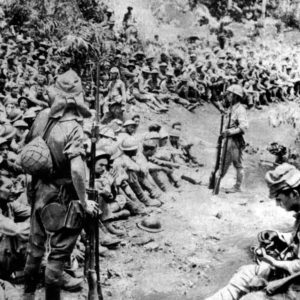Lesson Plan 8:

Filipino Guerrillas: What Were They Fighting For?
Students learn about the motivations and experiences of Filipino guerrillas during World War II by exploring the online exhibit Under One Flag and other sources, then write a first-person narrative from the point of view of a guerrilla.
Summary
In this lesson, students learn about the motivations and experiences of Filipino guerrillas during World War II by exploring the online exhibit Under One Flag and other online sources. Then, students select a historic photograph of a guerrilla and write a first-person narrative or design a profile card for them, synthesizing what they’ve learned to create a compelling composite character. The lesson concludes with a look at the Rescission Act, asking students to consider how their character would react.
This lesson builds on students’ prior knowledge about World War II in the Philippines, going deeper to look at the integral role guerrillas played in the course and outcome of the fight against the Japanese. We suggest spreading the lesson over at least two class periods to allow students time to research, write and share their work. The first and last steps can each be completed in about 15 minutes, with variable time in between for research and writing or design.
Key Ideas
1. Guerrillas had many motivations for fighting and complex relationships with the United States
2. Guerrillas fought at great personal risk and with incredible bravery against long odds, with few resources.
3. A wide variety of activities counted as guerrilla service; guerrilla warfare looks very different than typical military combat
4. Despite their essential service, guerrillas were not considered part of the U.S. military forces in the Philippines and after the war, this would make it difficult for guerrillas to claim veteran status and benefits
Time
1-2 class periods
Materials
- “Filipino Guerrillas Listening to Illegal Radio” Handout
- Filipino Guerrillas Research Worksheet
- “Rescission Act” Explainer https://dutytocountry.org/project/explainer-5/
- Laptops or tablets to access Under One Flag online exhibit
Grade Level/Subject
High School Social Studies
Common Core: High School
- CCSS.ELA-LITERACY.RH.11-12.2 Determine the central ideas or information of a primary or secondary source; provide an accurate summary that makes clear the relationships among the key details and ideas.
- CCSS.ELA-LITERACY.RH.11-12.9 Integrate information from diverse sources, both primary and secondary, into a coherent understanding of an idea or event, noting discrepancies among sources.
UCLA Public History Initiative | US History Content Standards
- Era 8, Standard 3: The causes and course of World War II, the character of the war at home and abroad, and its reshaping of the U.S. role in world affairs.
UCLA Public History Initiative | World History Content Standards
- Era 8, Standard 4B: The student understands the global scope, outcome, and human costs of World War II.
Instructions
1. Introduction: Who Were the guerrillas? (15 minutes)
Hand out “Filipino Guerrillas with Illegal Radio” and lead students through a close reading of the photo and quote from General MacArthur. Questions to probe:
- What’s going on in this photo? What details draw your attention?
- What’s the mood of the people in the photo? What clues or details help you determine this?
- A guerrilla fighter is defined as “a member of a small independent, grassroots group who takes part in irregular fighting against larger, official military or police forces.” What details in the photo (besides the caption) suggest that these are guerrillas?
- Why might radios like this have been illegal during the Japanese occupation? What risks were these guerrillas taking by possessing and listening to it? Why might they have taken these risks anyway?
- What does General MacArthur say about the importance of radios in the Philippines?
- What guerrilla activities does MacArthur describe directly? What other guerrilla activities can you infer from the quote and the photo?
- Overall, what is the tone of how MacArthur speaks about Filipino guerrillas?
If you have interest and time, the Army created a detailed map of wartime guerrilla radio networks in the Philippines. The map (Plate 87) and several other high-quality maps of guerrilla positions in the Philippines can be found here:
https://history.army.mil/books/wwii/macarthur%20reports/macarthur%20v1/ch10.htm
2. Pick Characters and Conduct Research (at least 30 minutes)
Tell students that in this lesson, they’ll be digging deep into the experiences and motivations of Filipino guerrillas during World War II. Based on their research, they’ll write a first-person narrative (or design a profile card) from the point of view of a Filipino guerrilla. They’ll conduct their research by exploring the online exhibit Under One Flag and online primary and secondary sources.
To get started, though, they need to pick a photo for inspiration. The Duty to Country team has curated four photos of anonymous guerrillas. Each student should choose one guerrilla they want to “get to know better” by doing research and writing their back story. They can then use the research worksheet to start reviewing materials and gathering information.
You can differentiate this portion of the activity by limiting the number and types of sources to review, as well as which questions to have students focus on in their research. For instance, you may ask lower-level students to focus on photographs and animations in the exhibit and have more advanced students read part or all of the 1950 report on Philippine guerrillas published by the U.S. military.
3. Write Narrative (time varies; can be completed as homework) and Share
The research worksheet includes instructions for writing a first-person narrative or designing a Profile Card. We recommend having students complete this as homework, then allow time during the next class to share their work. Assess narratives by level of detail, particularly the degree to which students address motivations, changing and difficult conditions over the course of the war, and the complexities of relations with the Americans.
You can differentiate this section by limiting the number of questions to address in their narratives or offering an alternate assignment to create a profile card based on the artwork/style of the Profile Cards (https://exhibition.dutytocountry.org/profile-cards/) in Under One Flag.
4. Conclusion: The Rescission Act (15 minutes)
Introduce the Rescission Act. The Rescission Act Explainer (https://dutytocountry.org/project/explainer-5/) in this curriculum includes the relevant text of the act and helpful background information for the teacher. Key points to relay to students include its rationale (to save money, especially now that the Philippines were independent), its implications (no pensions, medical care, immigration rights, or other benefits that other WWII vets received), and its effects (it kicked off a 70+ year movement to gain benefits and recognition).
Once students understand the Rescission Act, ask them to share how they think their character would react to the news. Ask them to consider not only how their character would feel, but also how they might take action to protest and right this wrong. You can have students share out in discussion or writing.
Note: Several other lessons and explainers in Duty to Country can help you go further to understand the Rescission Act and the activist movement it inspired. There is also an Explainer on the guerrilla roster (https://dutytocountry.org/project/explainer-8/). We suggest incorporating these additional materials and, when doing so, ask their students to return to their characters and imagine how they would react.
Related Explainers
Filipino Guerrillas: What Were They Fighting For?
Filipino guerrillas with Illegal Radio
This undated photo shows a group of Filipino guerrillas clustered around an illegal radio, listening for news of the war. It was likely taken after the fall of the Philippines in April 1942 and the final surrender of the Japanese in September 1945.

Source: Sandaan: One Hundred Years of Filipinos in America
The following excerpts are from General Douglas A. MarArthur’s remarks upon returning to the Philippines in October 1944:
Following the disaster which, in the face of overwhelming superior enemy power, overtook our gallant forces, a deep and impenetrable silence engulfed the Philippines [fall of the Philippines, April 1944]. Through that silence no news concerning the fate of the Filipino people reached the outside world until broken by a weak signal from a radio set on the Island of Panay which was picked up, in the late fall of that same fateful year, by listening posts of the War Department and flashed to my Headquarters [in Australia]. That signal, weak and short as it was, lifted the curtain of silence and uncertainty and disclosed the start of a human drama with few parallels in military history….
We are aided by the fact that for many months our plans of campaign have benefited from the hazardous labor of a vast network of agents numbering into the hundreds of thousands providing precise, accurate and detailed information on major enemy moves and installations throughout the Philippine Archipelago. We are aided by the fact that through a vast network of radio positions extending into every center of enemy activity and concentration throughout the islands, I have been kept in immediate and constant communication with such widespread sources of information.
Source: U.S. Army. Reports of General MacArthur: The Campaigns of MacArthur in the Pacific, Volume I. Prepared by His General Staff. 1950. https://history.army.mil/books/wwii/macarthur%20reports/macarthur%20v1/ch10.htm
Guerrilla Character Research and First-Person Narrative
Step 1: Choose Your Fighter
Select one of the guerrillas from the photos below. Each of the guerrillas pictured is anonymous; for this assignment, you’ll be gathering historical information to write their backstory. You’ll be evaluated on how well you incorporate relevant and plausible historical information based on the real-life experiences of Filipino guerrillas in World War II. The more specific you can be about where they fought, why they fought, what actions they took, what dangers they faced, how they felt about the Japanese and the Americans, the stronger your first-person narrative will be.
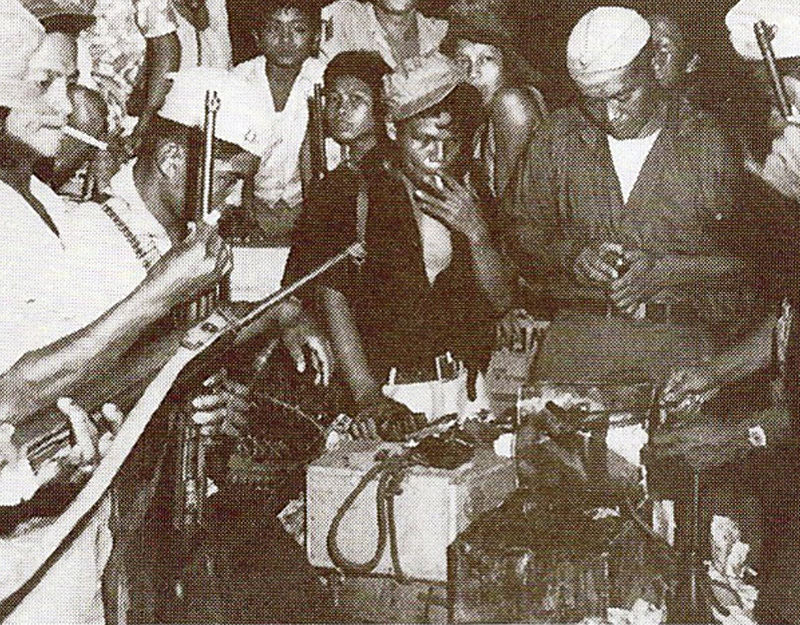
Filipino guerrillas cluster around a radio listening for news of the war.
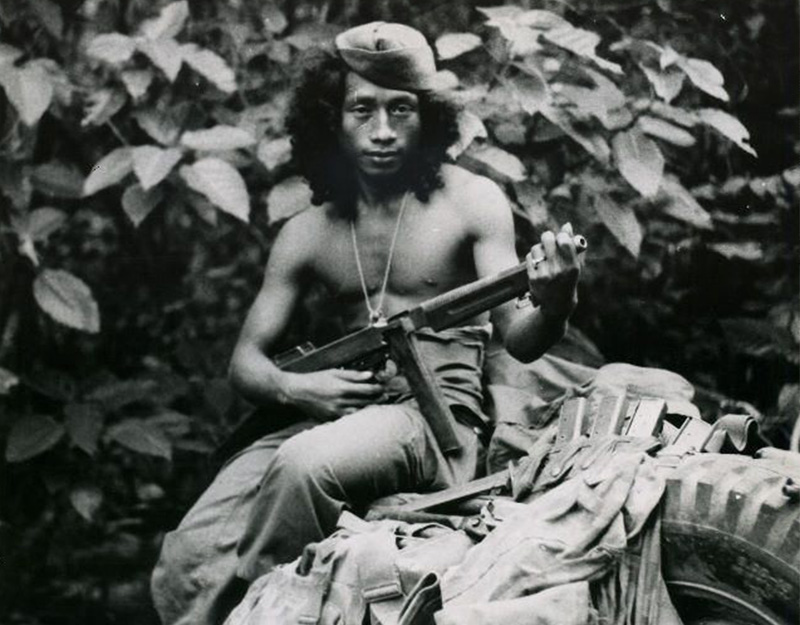
A guerrilla fighter poses with a Thompson machine gun while sitting on a Jeep in the jungles of the Philippines.
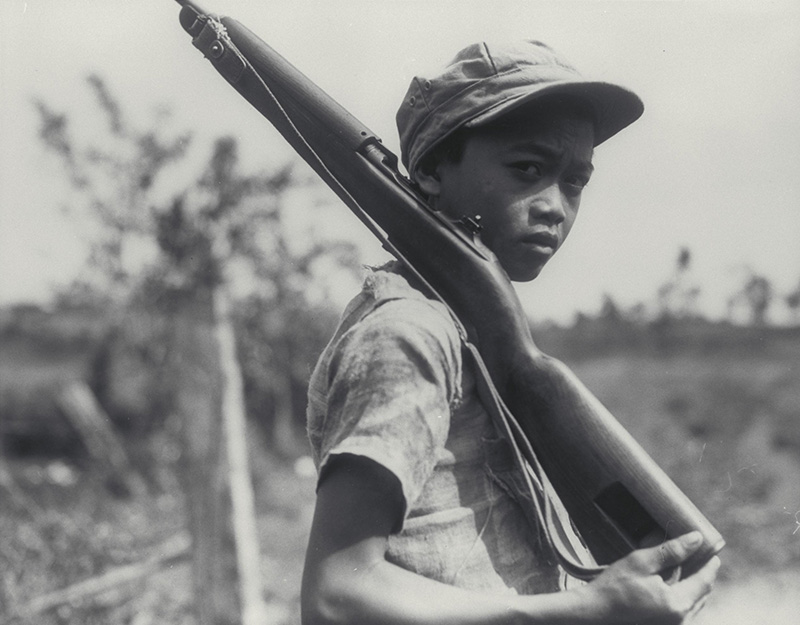
A 16-year-old guerrilla.
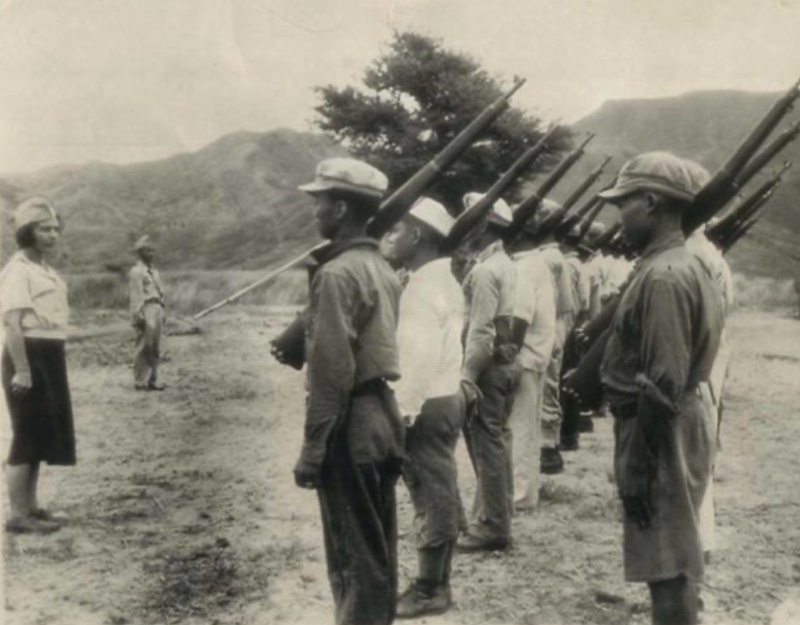
A female guerrilla commander oversees guerrilla fighters.
Step 2: Research
Use some or all of the following sources to gather relevant historical information to shape your character’s backstory. See the questions in Step 3 to guide your research.
- Under One Flag Exhibit (Chapter 2: The Crucible of War has the most information about the guerrillas’ experiences. This information is throughout the chapter, not just the section called “guerrillas.”) https://exhibition.dutytocountry.org/
- “MacArthur: The Guerrilla War” (Interviews with three guerrillas, two Americans, one Filipino) https://www.pbs.org/wgbh/americanexperience/features/macarthur-guerrilla-war/
- Oral History Interview with Celestino Almeda (Additional interviews can be found at the same site) https://dutytocountry.org/project/celestino-almeda/
- “Guerrilla Activities in the Philippines” (A chapter from General MacArthur’s reports of activities in the Pacific, 1950) https://history.army.mil/books/wwii/macarthur%20reports/macarthur%20v1/ch10.htm
Step 3: Imagine
Write a first-person narrative from the point of view of your character at the end of the war (September 1945). It should be at least 500 words. Your narrative should address the following questions:
- Why do you fight? What are you hoping will be accomplished by your service?
- Where do you fight?
- What kinds of activities are you engaged in? How are these efforts contributing to the war effort?
- What kinds of dangers and hardships have you faced?
- What are you most proud of?
- What has been your experience with the Americans (during the war)?
- How do you hope to be recognized, if at all, for your service?
Alternative assignment
Design a profile card for their character, based on the artwork/style of the Profile Cards (https://exhibition.dutytocountry.org/profile-cards/) in Under One Flag. Each profile card should include:
- A portrait illustration
- Four “symbols” in each corner representing the character’s experiences
- A short bio (125-150 words)

